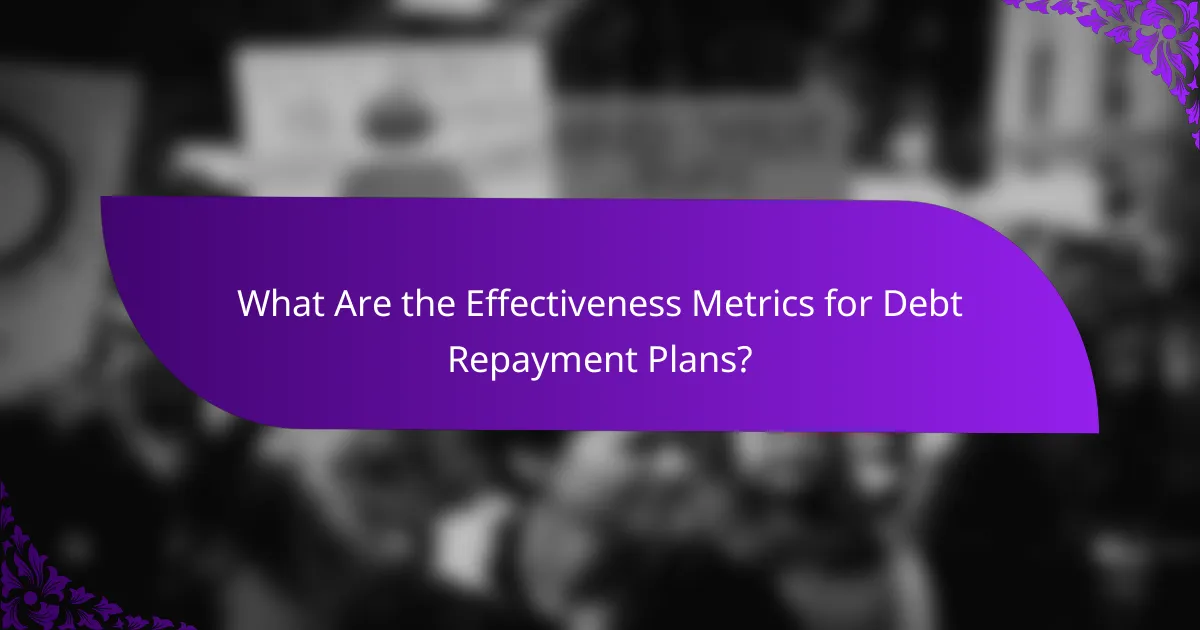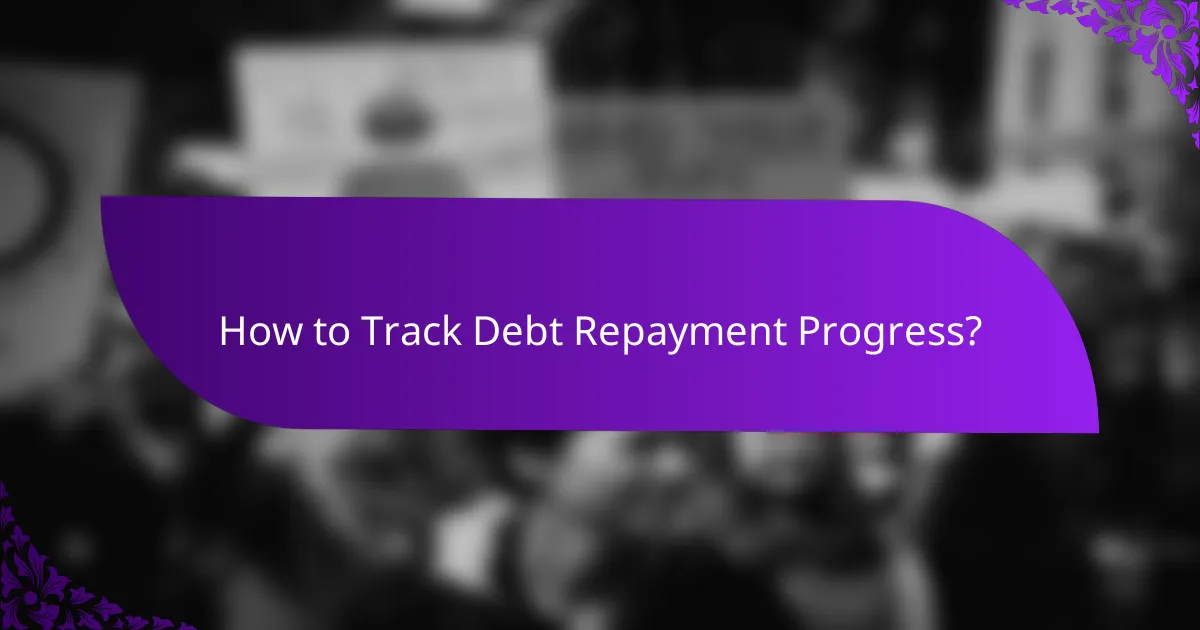Debt repayment plans can significantly impact your financial health, and their effectiveness often hinges on customization to fit individual circumstances. By exploring various strategies such as the Snowball and Avalanche methods, debt consolidation, and income-driven repayment options, you can create a tailored approach that aligns with your goals. Tracking your progress through key metrics will further enhance your ability to manage and reduce your debt effectively.

What Are the Best Debt Repayment Plans?
The best debt repayment plans vary based on individual financial situations and preferences. Key options include the Snowball method, Avalanche method, debt consolidation, income-driven repayment, and debt management plans, each with distinct strategies and benefits.
Snowball method
The Snowball method focuses on paying off the smallest debts first, regardless of interest rates. This approach can provide quick wins, boosting motivation as you eliminate debts one by one.
To implement this method, list your debts from smallest to largest. Make minimum payments on all but the smallest debt, and put any extra funds toward that debt until it is paid off. Then, move to the next smallest debt.
Avalanche method
The Avalanche method prioritizes debts with the highest interest rates, which can save money over time. This strategy is effective for those who want to minimize interest payments and pay off debt more efficiently.
To use the Avalanche method, list your debts from highest to lowest interest rate. Make minimum payments on all debts except the one with the highest rate, directing any extra funds toward that debt until it is cleared. Then, proceed to the next highest rate.
Debt consolidation
Debt consolidation combines multiple debts into a single loan, often with a lower interest rate. This can simplify payments and potentially reduce monthly costs.
Consider options like personal loans or balance transfer credit cards. Ensure you understand the terms and fees associated with consolidation, as these can impact overall savings.
Income-driven repayment
Income-driven repayment plans are designed for federal student loans, adjusting monthly payments based on income and family size. This can make payments more manageable for borrowers with fluctuating incomes.
To qualify, apply through your loan servicer and provide necessary documentation. Be aware that remaining balances may be forgiven after a set period, typically 20 to 25 years, depending on the plan.
Debt management plans
Debt management plans (DMPs) involve working with a credit counseling agency to create a structured repayment plan. These plans can help reduce interest rates and consolidate payments into one monthly amount.
To start a DMP, consult a certified credit counselor who can assess your financial situation and negotiate with creditors on your behalf. Be cautious of fees and ensure the agency is reputable before committing.

How to Customize a Debt Repayment Plan?
Customizing a debt repayment plan involves tailoring strategies to fit your financial situation, goals, and lifestyle changes. By assessing your current finances, setting achievable targets, and selecting suitable repayment methods, you can create a plan that effectively reduces your debt burden.
Assessing financial situation
Start by reviewing your income, expenses, and existing debts. Calculate your total monthly income and subtract your essential expenses to determine how much you can allocate toward debt repayment. This assessment will help you understand your financial capacity and identify any areas where you can cut costs.
Consider using a budgeting tool or spreadsheet to track your finances. This will provide a clear picture of your cash flow and help you make informed decisions about your repayment plan.
Setting realistic goals
Establish specific, measurable, achievable, relevant, and time-bound (SMART) goals for your debt repayment. For example, aim to pay off a certain percentage of your debt within a year or reduce your monthly payments by a set amount. Setting realistic goals keeps you motivated and allows for adjustments as needed.
Break larger goals into smaller milestones to celebrate progress along the way. This can help maintain your commitment and provide a sense of accomplishment as you reach each target.
Choosing repayment strategies
Select a repayment strategy that aligns with your financial situation and goals. Common methods include the snowball method, where you pay off the smallest debts first, or the avalanche method, which focuses on the highest interest debts. Each strategy has its pros and cons, so consider which one suits your personality and financial habits best.
Evaluate the possibility of consolidating debts into a single loan with a lower interest rate. This can simplify payments and potentially reduce the total interest paid over time.
Incorporating income changes
Be prepared to adjust your debt repayment plan as your income changes. If you receive a raise or a bonus, consider allocating a portion of that increase toward your debt. Conversely, if your income decreases, reassess your budget and repayment goals to ensure they remain manageable.
Stay informed about potential side income opportunities, such as freelance work or part-time jobs, which can provide additional funds for debt repayment. Regularly revisiting your financial situation will help you stay on track and adapt to any changes effectively.

What Are the Effectiveness Metrics for Debt Repayment Plans?
The effectiveness of debt repayment plans can be measured through several key metrics that indicate progress and financial health. Understanding these metrics helps individuals assess their repayment strategies and make informed decisions.
Debt-to-income ratio
The debt-to-income (DTI) ratio is a crucial metric that compares an individual’s total monthly debt payments to their gross monthly income. A lower DTI indicates better financial health, as it shows that a smaller portion of income is going towards debt repayment.
To calculate your DTI, divide your total monthly debt payments by your gross monthly income and multiply by 100. For example, if your monthly debts total $1,500 and your gross income is $5,000, your DTI would be 30%. A DTI below 36% is generally considered manageable.
Time to debt freedom
Time to debt freedom refers to the duration it will take to completely pay off debts under a specific repayment plan. This metric is essential for setting realistic financial goals and maintaining motivation throughout the repayment process.
To estimate your time to debt freedom, consider your total debt amount, interest rates, and monthly payments. For instance, if you owe $10,000 at a 15% interest rate and pay $300 monthly, it may take around 4 years to become debt-free. Shorter repayment times often reduce the total interest paid.
Impact on credit score
The impact of a debt repayment plan on your credit score is significant, as timely payments can improve your score, while missed payments can harm it. Credit scores are influenced by factors such as payment history, credit utilization, and the length of credit history.
To maintain or improve your credit score during repayment, ensure that payments are made on time and avoid accumulating new debt. Regularly monitoring your credit report can help you track changes and identify areas for improvement.
Monthly payment affordability
Monthly payment affordability assesses whether an individual can comfortably make their debt payments without compromising essential living expenses. This metric is vital to prevent financial strain and potential default.
To determine affordability, calculate your monthly budget and ensure that debt payments do not exceed a certain percentage of your income, typically around 20-30%. If payments are too high, consider negotiating lower interest rates or extending the repayment period to reduce monthly obligations.

How to Track Debt Repayment Progress?
Tracking debt repayment progress is essential for managing your finances effectively. By monitoring your payments and remaining balances, you can stay motivated and adjust your strategies as needed.
Using budgeting apps
Budgeting apps are powerful tools for tracking debt repayment. They allow you to input your debts, set repayment goals, and visualize your progress through graphs and charts. Popular options include Mint, YNAB (You Need a Budget), and EveryDollar.
When choosing an app, look for features like automatic syncing with bank accounts, customizable categories, and reminders for upcoming payments. Many apps also provide insights into your spending habits, helping you allocate more funds toward debt repayment.
Creating a repayment timeline
A repayment timeline outlines when you plan to pay off each debt. Start by listing all your debts, including amounts owed and interest rates, then prioritize them based on urgency or cost. This helps you allocate funds effectively and stay on track.
Consider using the snowball or avalanche method for repayment strategies. The snowball method focuses on paying off the smallest debts first, while the avalanche method targets debts with the highest interest rates. Both approaches can be effective, depending on your financial situation and motivation.
Monitoring credit reports
Regularly checking your credit report is crucial for tracking debt repayment progress. It provides insights into your credit utilization, payment history, and overall credit score. In the U.S., you can obtain a free credit report annually from each of the three major credit bureaus.
Look for updates on your debts and ensure that all payments are accurately reflected. Discrepancies can affect your credit score and repayment strategy. If you notice any errors, dispute them promptly to maintain an accurate credit profile.
Setting reminders for payments
Setting reminders for payments is a simple yet effective way to ensure you never miss a due date. Use calendar apps, budgeting apps, or even sticky notes to remind yourself of upcoming payments. Consistency is key to avoiding late fees and maintaining a positive credit history.
Consider setting reminders a few days before the due date to give yourself time to prepare. Automating payments can also help, but ensure you have sufficient funds in your account to avoid overdraft fees. Regularly review your payment schedule to stay aligned with your repayment goals.

What Are the Common Mistakes in Debt Repayment?
Common mistakes in debt repayment can significantly hinder your progress towards financial freedom. Key pitfalls include overlooking interest rates and missing payments, both of which can lead to increased debt and prolonged repayment periods.
Ignoring interest rates
Ignoring interest rates can be detrimental to your debt repayment strategy. High-interest debts, such as credit cards, can accumulate quickly, making it harder to pay off the principal amount. Prioritize paying off debts with the highest interest rates first to minimize overall costs.
Consider using the avalanche method, where you focus on the debt with the highest interest rate while making minimum payments on others. This approach can save you money in the long run and help you pay off your debts faster.
Missing payments
Missing payments can lead to late fees, increased interest rates, and a negative impact on your credit score. Staying organized with your payment schedule is crucial to avoid these consequences. Set up reminders or automate payments to ensure you never miss a due date.
Additionally, consider creating a budget that allocates funds specifically for debt repayment. This proactive approach can help you manage your finances better and keep your repayment plan on track.